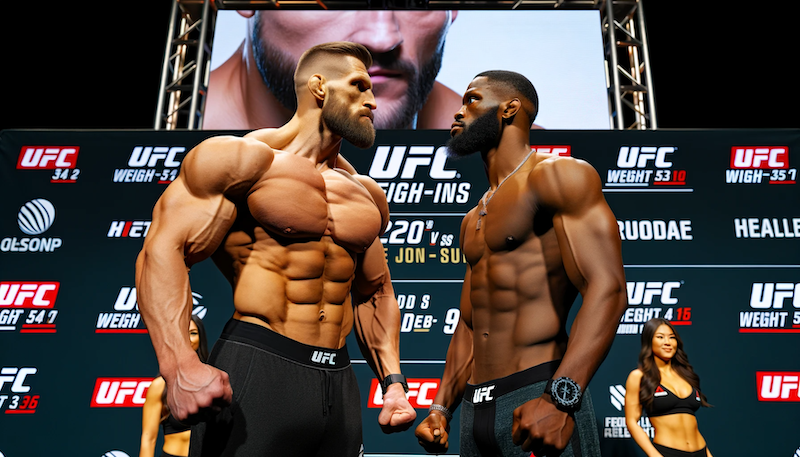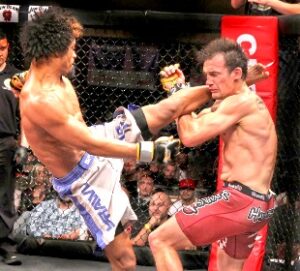
Have you recently heard YouTuber and bodybuilder Bradley Martyn claiming he could beat Nate Diaz (former UFC fighter) and Devin Haney (pro boxer) in a fight?
He also asked Brendan Schaub (former UFC heavyweight), Aljamain Sterling (former UFC bantamweight champion), and Sean O’Malley (UFC bantamweight champion – 135 lbs) whether they believed he could beat them in a fight.
In this article, we’ll go over the bodybuilder vs MMA fighter fight scenario, explaining why the MMA fighter wins 99% of the time – even at a huge weight disadvantage of 50 lbs or more.
Bodybuilder vs MMA Fighter: Who Wins?
Despite the apparent size and strength advantage of bodybuilders, when it comes to an actual fight, whether it be a Bjj match, MMA fight, street fight, or any kind of fight, MMA fighters consistently come out on top.
MMA fighters win because they possess a blend of attributes essential for fighting. Their strikes are powered by superior technique and strength. They have exceptional cardiovascular endurance and a higher fight IQ, while remarkable agility and speed give them an edge in maneuverability.
Lastly, they’re equipped with robust pain tolerance, a wealth of experience in pressure-filled situations, and astute energy management skills.
Let’s take a closer look at the 9 reasons why MMA fighters beat bodybuilders in a fight.
1. MMA Fighters Are Versatile Combat Experts
Unlike bodybuilders, MMA fighters are rigorously trained in various fighting styles. This versatility allows them to adapt to different fighting situations, making them skilled in any scenario.
MMA fighters are well-equipped to handle both stand-up and ground fighting, meaning they can fight in any direction the fight is taken.
Often, a much larger and stronger bodybuilder will try to grapple an MMA fighter as they believe they can use their larger size, weight, and strength to control them and look for ground and pound.
However, an MMA fighter, competent in wrestling and Brazilian jiu-jitsu, would be able to easily reverse positions on the ground and initiate control.
MMA athletes are skilled in using leverage, redirecting energy, and manipulating an opponent’s weight to gain a strategic advantage.
Even at a huge weight disadvantage of 50 lbs or more, the MMA fighter would be able to defend takedowns and keep their distance with striking, movement, and footwork that the bodybuilder doesn’t have.
This would negate the bodybuilder’s most likely route to victory.
In this 1994 MMA fight between a 150 lb Brazilian jiu-jitsu black belt vs a 250 lb bodybuilder, the Bjj fighter is more skilled in both the standup striking and on the ground, and ends up winning via arm bar.
2. Superior Technique
A key advantage MMA fighters hold over bodybuilders is their superior combat technique, involving the nuanced application of force, leverage, and timing.
Despite being smaller and potentially weaker than their bodybuilder counterparts, MMA fighters are trained to generate significant force in their strikes through precise technique.
They understand how to maximize impact with minimal effort, using the entire body’s mechanics – from foot rotation to hip movement – to deliver powerful strikes.
Moreover, technique in MMA includes mastering defensive tactics, which allows fighters to guard against attacks, even from physically stronger opponents effectively.
Their training in various martial arts disciplines provides them with a broad arsenal of moves and counters, enabling them to outmaneuver and outsmart opponents who rely primarily on brute strength.
This technical prowess also extends to grappling and ground fighting, where skill and technique can neutralize the strength advantage of a larger opponent.
MMA fighters use joint locks, chokes, and position control not just to subdue, but to strategically exhaust their adversaries, making size and muscle mass less relevant in the heat of combat.
Here’s a video showing a much larger bodybuilder fighting against an MMA fighter.
The MMA fighter easily wins within 40 seconds through simple techniques, whereas the bodybuilder lacks both the technique and skills to compete.
3. Superior Cardiovascular Endurance
Bodybuilders, though muscular, often neglect cardiovascular training necessary for prolonged physical exertion.
Especially compared to the 15 to 25 minutes of intense fighting that MMA fighters are accustomed to.
Their large muscles require more oxygen, leading to quicker exhaustion compared to the more endurance-focused training of MMA fighters.
Historical evidence and numerous MMA matches have shown that ‘skinny fighters’ regularly beat larger, more muscular, but less mobile opponents.
They’re able to keep a high tempo, apply forward pressure, and fight at maximum as their opponent tires.
The size and strength advantage of a bodybuilder quickly disappears as they tire and lose energy to continue fighting.
4. Fight IQ and Tactical Skills
MMA fighters possess a high “fight IQ”, which means they understand the dynamics of a fight better.
They’re trained to exploit weaknesses, anticipate moves, and strategize effectively in real-time. MMA is often described as a chess match.
This intelligence extends beyond physical tactics and results in a deep understanding of the psychological elements of combat.
Unlike bodybuilders, who might be overconfident due to their size and strength, as people are often intimidated by them, MMA fighters approach each fight with humility and composure.
Their ability to read opponents’ intentions and body language and use their overconfidence against them is a key component of their fight IQ.
For instance, they can time their moves to counteract predictable, strength-based attacks from bodybuilders, such as ducking under a heavy punch and securing a takedown.
This mental acuity, combined with physical skills, gives MMA fighters a significant advantage in combat situations.
5. Greater Agility and Speed
The training regimen of MMA fighters often includes developing agility and speed in everything they do.
They can quickly change direction, react instantly to opponents’ moves, and execute complex techniques precisely. They have fast footwork, head and body movement, and decision-making skills.
By contrast, bodybuilders often focus on muscle mass and strength, which can reduce their overall agility, quickness, and range of motion.
The bulkier physique of a bodybuilder often leads to slower movements and reactions, making it difficult to keep pace with the nimble and swift techniques and movement of an MMA fighter.
This disparity in agility and speed can be a decisive factor in a combat situation, where a split-second advantage can mean the difference between landing a strike or getting countered.
In this short fight between a 150 lb MMA fighter vs a much larger bodybuilder, the MMA fighter fakes a strike and secures a takedown with great speed.
He then lands ground-and-pound, threatens submissions, and easily keeps the bodybuilder on the ground.
6. Experience in Real Combat Situations
Regular MMA sparring and competition give MMA fighters a practical edge. Their experience experience teaches them to handle adrenaline rushes, navigate through the chaos of a fight, and make split-second decisions under pressure.
They learn to adjust their strategies based on real-time feedback from their opponents, making them adept at handling unforeseen circumstances.
Furthermore, exposure to different fighting styles and techniques in these situations broadens their repertoire and adaptability, both mentally and physically.
On the other hand, bodybuilders are likely to become flustered and panicked in a fight, as their training is focused on physical aesthetics rather than combat readiness under pressure.
7. Better Pain Tolerance
MMA training involves conditioning to withstand pain and recover from hits so that they can continue fighting, a crucial aspect not typically focused on in bodybuilding.
MMA fighters are trained to endure physical pain from strikes, throws, and submissions. This conditioning extends to mental resilience, where they learn to stay composed and strategic even when hurt.
By contrast, most bodybuilders haven’t experienced the intensity of combat pain, like a broken nose from a powerful punch or a roundhouse kick to the liver.
Most bodybuilders are overwhelmed by the shock and reality of this pain and quickly admit defeat.
8. Effective Energy Management
In a fight, managing energy efficiently is crucial. MMA fighters are trained to conserve energy and use it strategically, a skill honed through rigorous training and real fight experience.
They learn to recognize when to exert maximum effort and when to conserve energy for critical moments.
This involves understanding the rhythm of a fight, recognizing the ebb and flow of combat, and using techniques that are effective yet energy-conserving.
Additionally, MMA training often includes exercises that improve muscle efficiency, enabling fighters to perform high-intensity actions without quickly depleting their energy reserves.
This strategic approach to energy management is a key differentiator in a fight, allowing MMA fighters to maintain peak performance over longer periods.
On the other hand, bodybuilders don’t have the same level of training in energy conservation and would expend their energy rapidly, leading to quicker fatigue and eventually losing the fight.
9. The Detriment of Excessive Weight
While bodybuilders might have a size and strength advantage due to their heavier weight, this can become a detriment in a combat scenario, especially past a certain threshold.
In the world of professional MMA, particularly in the UFC, many successful heavyweights weigh well under the maximum limit of 265 lbs.
Renowned fighters like Daniel Cormier, Cain Velasquez, and Stipe Miocic have typically fought around 240 lbs, while Jon Jones recently weighed 248 lbs before his heavyweight title win.
This weight range strikes an optimal balance between strength, speed, technical ability, and endurance – all factors necessary for success in MMA fighting.
Bodybuilders are attempting to add more muscle mass to the detriment of everything else, and would find that their extra weight hinders their mobility, speed, and stamina in a fight.
The agility and endurance required in combat sports can be compromised by excessive weight, turning a perceived advantage into a liability.
To Conclude
In conclusion, while bodybuilders have the advantage of size and strength, the comprehensive training, tactical skills, superior cardiovascular endurance, and fight experience of MMA fighters give them the upper hand in a fight.
This blend of physical prowess, strategic thinking, and combat readiness makes MMA fighters formidable opponents, capable of overcoming challenges posed by much larger opponents.
The only time a bodybuilder has a chance is if they weigh 50 lbs or more than the MMA fighter, and even then their win is unlikely as they tire and become unable to fight.




